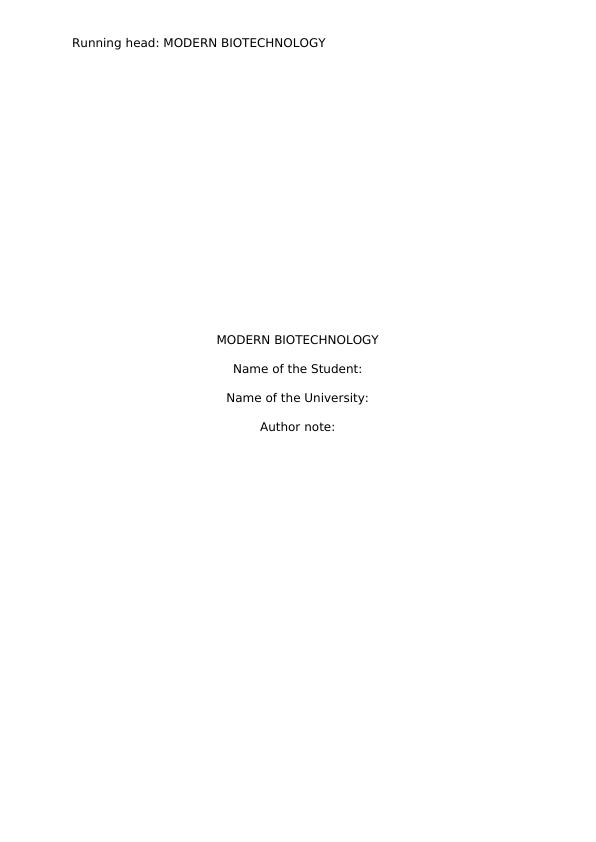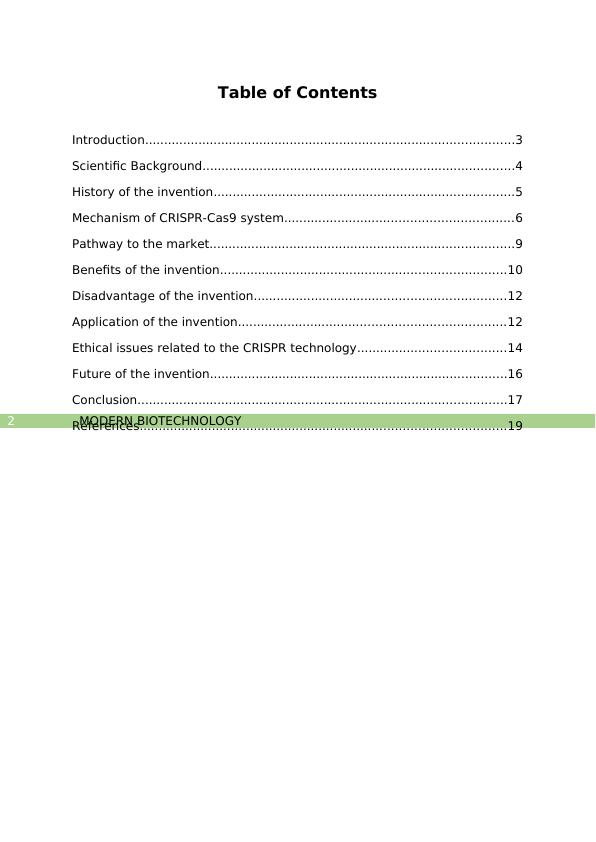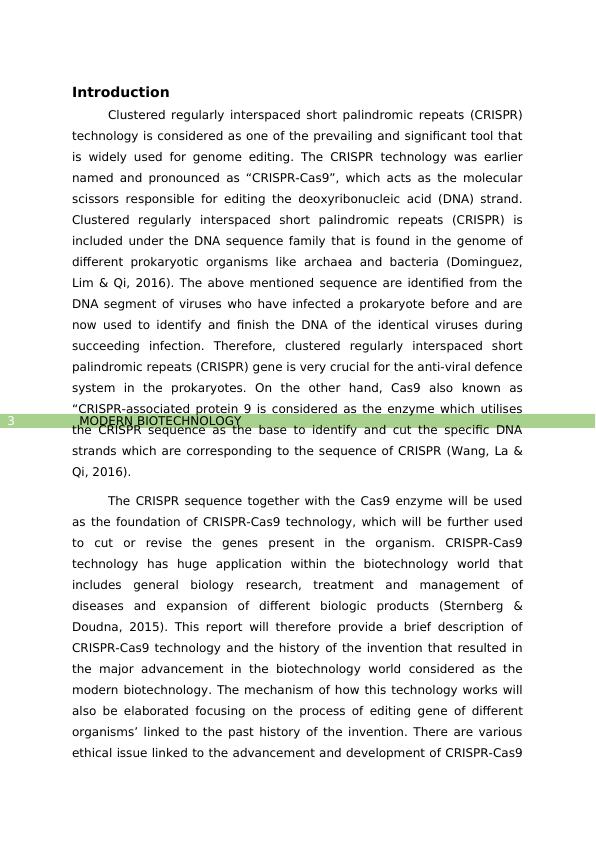Assignment | MODERN BIOTECHNOLOGY
25 Pages6727 Words17 Views
Added on 2022-10-01
Assignment | MODERN BIOTECHNOLOGY
Added on 2022-10-01
ShareRelated Documents
Running head: MODERN BIOTECHNOLOGY
MODERN BIOTECHNOLOGY
Name of the Student:
Name of the University:
Author note:
MODERN BIOTECHNOLOGY
Name of the Student:
Name of the University:
Author note:

MODERN BIOTECHNOLOGY1
Executive Summary
This report will focus on the CRISPR-Cas9 system and their
application in the scientific market. Clustered regularly interspaced short
palindromic repeats (CRISPR) technology is one of the most advanced and
potent genome-editing technology that acts as the molecular scissors
responsible for editing the deoxyribonucleic acid (DNA) strand. Cas9 also
recognized as “CRISPR-associated protein 9” is reflected as the enzyme
which develops the CRISPR sequence as the base to identify and cut the
precise DNA strands which are equivalent to the sequence of CRISPR.
There are various benefits of using this system in the biotechnology field
as it would aid in the development, treatment and management of
diseases and expansion of different biologic products. This report will
highlight the scientific background of the CRISPR-Cas9 system relating to
the events that had resulted in the invention of this system associated
with the past history of the invention. The series of events that took place
during the invention of this system will also be explained in this report.
The CRISPR-Cas9 system functions by introducing the Cas9 protein into
the chaperon RNA related to the precise DNA sequence which will
chaperon the Cas9 protein to identify and cut the target DNA and trigger
the healing mechanism of the DNA. The advantages and drawbacks of
using CRISPR-Cas9 system will be explained in the report for identifying
the advancement of this system to the global market and estimating the
level of customer satisfaction. The CRISPR-Cas9 system has various
ethical and safety problems because this system works with the human
embryo and germ line cells. The incorrect alteration of the human cells
will lead to the adverse actions that might have a deleterious effect on the
future generations. Thus, it is very crucial that the scientist conduct an
extensive research based on the future perspective and try to reduce any
possible risk associated with this system.
Executive Summary
This report will focus on the CRISPR-Cas9 system and their
application in the scientific market. Clustered regularly interspaced short
palindromic repeats (CRISPR) technology is one of the most advanced and
potent genome-editing technology that acts as the molecular scissors
responsible for editing the deoxyribonucleic acid (DNA) strand. Cas9 also
recognized as “CRISPR-associated protein 9” is reflected as the enzyme
which develops the CRISPR sequence as the base to identify and cut the
precise DNA strands which are equivalent to the sequence of CRISPR.
There are various benefits of using this system in the biotechnology field
as it would aid in the development, treatment and management of
diseases and expansion of different biologic products. This report will
highlight the scientific background of the CRISPR-Cas9 system relating to
the events that had resulted in the invention of this system associated
with the past history of the invention. The series of events that took place
during the invention of this system will also be explained in this report.
The CRISPR-Cas9 system functions by introducing the Cas9 protein into
the chaperon RNA related to the precise DNA sequence which will
chaperon the Cas9 protein to identify and cut the target DNA and trigger
the healing mechanism of the DNA. The advantages and drawbacks of
using CRISPR-Cas9 system will be explained in the report for identifying
the advancement of this system to the global market and estimating the
level of customer satisfaction. The CRISPR-Cas9 system has various
ethical and safety problems because this system works with the human
embryo and germ line cells. The incorrect alteration of the human cells
will lead to the adverse actions that might have a deleterious effect on the
future generations. Thus, it is very crucial that the scientist conduct an
extensive research based on the future perspective and try to reduce any
possible risk associated with this system.

MODERN BIOTECHNOLOGY2
Table of Contents
Introduction.................................................................................................3
Scientific Background..................................................................................4
History of the invention...............................................................................5
Mechanism of CRISPR-Cas9 system............................................................6
Pathway to the market................................................................................9
Benefits of the invention...........................................................................10
Disadvantage of the invention..................................................................12
Application of the invention......................................................................12
Ethical issues related to the CRISPR technology.......................................14
Future of the invention..............................................................................16
Conclusion.................................................................................................17
References................................................................................................19
Table of Contents
Introduction.................................................................................................3
Scientific Background..................................................................................4
History of the invention...............................................................................5
Mechanism of CRISPR-Cas9 system............................................................6
Pathway to the market................................................................................9
Benefits of the invention...........................................................................10
Disadvantage of the invention..................................................................12
Application of the invention......................................................................12
Ethical issues related to the CRISPR technology.......................................14
Future of the invention..............................................................................16
Conclusion.................................................................................................17
References................................................................................................19

MODERN BIOTECHNOLOGY3
Introduction
Clustered regularly interspaced short palindromic repeats (CRISPR)
technology is considered as one of the prevailing and significant tool that
is widely used for genome editing. The CRISPR technology was earlier
named and pronounced as “CRISPR-Cas9”, which acts as the molecular
scissors responsible for editing the deoxyribonucleic acid (DNA) strand.
Clustered regularly interspaced short palindromic repeats (CRISPR) is
included under the DNA sequence family that is found in the genome of
different prokaryotic organisms like archaea and bacteria (Dominguez,
Lim & Qi, 2016). The above mentioned sequence are identified from the
DNA segment of viruses who have infected a prokaryote before and are
now used to identify and finish the DNA of the identical viruses during
succeeding infection. Therefore, clustered regularly interspaced short
palindromic repeats (CRISPR) gene is very crucial for the anti-viral defence
system in the prokaryotes. On the other hand, Cas9 also known as
“CRISPR-associated protein 9 is considered as the enzyme which utilises
the CRISPR sequence as the base to identify and cut the specific DNA
strands which are corresponding to the sequence of CRISPR (Wang, La &
Qi, 2016).
The CRISPR sequence together with the Cas9 enzyme will be used
as the foundation of CRISPR-Cas9 technology, which will be further used
to cut or revise the genes present in the organism. CRISPR-Cas9
technology has huge application within the biotechnology world that
includes general biology research, treatment and management of
diseases and expansion of different biologic products (Sternberg &
Doudna, 2015). This report will therefore provide a brief description of
CRISPR-Cas9 technology and the history of the invention that resulted in
the major advancement in the biotechnology world considered as the
modern biotechnology. The mechanism of how this technology works will
also be elaborated focusing on the process of editing gene of different
organisms’ linked to the past history of the invention. There are various
ethical issue linked to the advancement and development of CRISPR-Cas9
Introduction
Clustered regularly interspaced short palindromic repeats (CRISPR)
technology is considered as one of the prevailing and significant tool that
is widely used for genome editing. The CRISPR technology was earlier
named and pronounced as “CRISPR-Cas9”, which acts as the molecular
scissors responsible for editing the deoxyribonucleic acid (DNA) strand.
Clustered regularly interspaced short palindromic repeats (CRISPR) is
included under the DNA sequence family that is found in the genome of
different prokaryotic organisms like archaea and bacteria (Dominguez,
Lim & Qi, 2016). The above mentioned sequence are identified from the
DNA segment of viruses who have infected a prokaryote before and are
now used to identify and finish the DNA of the identical viruses during
succeeding infection. Therefore, clustered regularly interspaced short
palindromic repeats (CRISPR) gene is very crucial for the anti-viral defence
system in the prokaryotes. On the other hand, Cas9 also known as
“CRISPR-associated protein 9 is considered as the enzyme which utilises
the CRISPR sequence as the base to identify and cut the specific DNA
strands which are corresponding to the sequence of CRISPR (Wang, La &
Qi, 2016).
The CRISPR sequence together with the Cas9 enzyme will be used
as the foundation of CRISPR-Cas9 technology, which will be further used
to cut or revise the genes present in the organism. CRISPR-Cas9
technology has huge application within the biotechnology world that
includes general biology research, treatment and management of
diseases and expansion of different biologic products (Sternberg &
Doudna, 2015). This report will therefore provide a brief description of
CRISPR-Cas9 technology and the history of the invention that resulted in
the major advancement in the biotechnology world considered as the
modern biotechnology. The mechanism of how this technology works will
also be elaborated focusing on the process of editing gene of different
organisms’ linked to the past history of the invention. There are various
ethical issue linked to the advancement and development of CRISPR-Cas9

MODERN BIOTECHNOLOGY4
technology that will be elaborated in the report, also stating the benefit of
the invention, disadvantage of the invention and the application of the
invention in the market. Hence, CRISPR-Cas9 technology is considered as
one of the recent and modern advancement in biotechnology that is
widely used in the market and has gained attention of various researchers
for understanding the diseases by using animal models and cells thus
making the chronic or complex disease prevention and treatment easier
(Singh, Braddick & Dhar, 2017).
Scientific Background
The concept of practising the genome-editing technology in order to
prevent diseases was under discovery since 1950s as soon as the double-
helix DNA structure was identified. Mid-20th century was considered as the
period of discovery in the genetic world where the researchers had
assumed and understood that the bases of DNA sequence is delivered
authentically from the parent to their offspring’s and therefore, that minor
alterations in the DNA sequence can be used to identify the difference
among well-being and disease (Quetier, 2016). This recognition resulted in
unavoidable conjecture stating that the identification of the “molecular
mistakes” will lead to different genetic diseases and the strategies to fix
the molecular mistakes by enabling the reversal or prevention of the
diseases in an individual. Hence, this concept was considered as the
significant idea for the development of gene therapy within the molecular
genetics. The idea of genome-editing technology was thus established
succeeding to gene therapy (Ledford, 2015).
The function or mechanism of the CRISPR sequence was unknown to
many researcher during 1987, when the Japanese researchers were
studying the
Escherichia coli bacteria and identified the unfamiliar
repeating sequences within the DNA of the organisms. They were unable
to identify the biological significance of the repeating sequence. As the
time passed, the other researchers who were working with different
bacteria (archaea) identified the same DNA sequence and therefore
named this sequence as Clustered regularly interspaced short palindromic
technology that will be elaborated in the report, also stating the benefit of
the invention, disadvantage of the invention and the application of the
invention in the market. Hence, CRISPR-Cas9 technology is considered as
one of the recent and modern advancement in biotechnology that is
widely used in the market and has gained attention of various researchers
for understanding the diseases by using animal models and cells thus
making the chronic or complex disease prevention and treatment easier
(Singh, Braddick & Dhar, 2017).
Scientific Background
The concept of practising the genome-editing technology in order to
prevent diseases was under discovery since 1950s as soon as the double-
helix DNA structure was identified. Mid-20th century was considered as the
period of discovery in the genetic world where the researchers had
assumed and understood that the bases of DNA sequence is delivered
authentically from the parent to their offspring’s and therefore, that minor
alterations in the DNA sequence can be used to identify the difference
among well-being and disease (Quetier, 2016). This recognition resulted in
unavoidable conjecture stating that the identification of the “molecular
mistakes” will lead to different genetic diseases and the strategies to fix
the molecular mistakes by enabling the reversal or prevention of the
diseases in an individual. Hence, this concept was considered as the
significant idea for the development of gene therapy within the molecular
genetics. The idea of genome-editing technology was thus established
succeeding to gene therapy (Ledford, 2015).
The function or mechanism of the CRISPR sequence was unknown to
many researcher during 1987, when the Japanese researchers were
studying the
Escherichia coli bacteria and identified the unfamiliar
repeating sequences within the DNA of the organisms. They were unable
to identify the biological significance of the repeating sequence. As the
time passed, the other researchers who were working with different
bacteria (archaea) identified the same DNA sequence and therefore
named this sequence as Clustered regularly interspaced short palindromic

MODERN BIOTECHNOLOGY5
repeats (CRISPR) (Ishino, Krupovic & Forterre, 2018). The vital function of
this sequence was still a big mystery for the researcher till 2007, when
different set of food scientist identified the function of these bacteria for
making yoghurt and hence concluded that this CRISPR sequence is
beneficial and considered as the significant part of the immune system of
bacteria. It was very clear that the immune system of the prokaryotic
organisms are responsive to the genome engineering and offers flexibility
as well as ease for scaling and multiplexing that can be therefore used as
the defensive strategy against the foreign invaders and treatment of the
diseases (Selle & Barrangou, 2015).
Source: (Ishino, Krupovic & Forterre, 2018)
History of the invention
The Clustered regularly interspaced short palindromic repeats
(CRISPR) sequence was primarily recognized among archaea in the form
of adaptive defensive process, which deliberates the process of resistance
to the external genetic elements. After the invention of the benefit of
CRISPR sequence, the complete CRISPR-Cas9 system was planned in the
form of flexible genome-editing tool that would help the researcher to
permit the alteration of downstream protospacer adjacent motif (PAM)
repeats (CRISPR) (Ishino, Krupovic & Forterre, 2018). The vital function of
this sequence was still a big mystery for the researcher till 2007, when
different set of food scientist identified the function of these bacteria for
making yoghurt and hence concluded that this CRISPR sequence is
beneficial and considered as the significant part of the immune system of
bacteria. It was very clear that the immune system of the prokaryotic
organisms are responsive to the genome engineering and offers flexibility
as well as ease for scaling and multiplexing that can be therefore used as
the defensive strategy against the foreign invaders and treatment of the
diseases (Selle & Barrangou, 2015).
Source: (Ishino, Krupovic & Forterre, 2018)
History of the invention
The Clustered regularly interspaced short palindromic repeats
(CRISPR) sequence was primarily recognized among archaea in the form
of adaptive defensive process, which deliberates the process of resistance
to the external genetic elements. After the invention of the benefit of
CRISPR sequence, the complete CRISPR-Cas9 system was planned in the
form of flexible genome-editing tool that would help the researcher to
permit the alteration of downstream protospacer adjacent motif (PAM)

End of preview
Want to access all the pages? Upload your documents or become a member.
Related Documents
CRISPR Gene Editing Research in Geneticslg...
|16
|4555
|199
CRISPR cas9 in Genome Editinglg...
|13
|3614
|43
CRISPR Gene Editinglg...
|9
|1979
|467
Applications of CRISPR-Cas Technology in S. thermophilus Bacterial Adaptive Immunitylg...
|21
|7383
|400
(PDF) Designer Babies CRISPRlg...
|21
|5669
|192
Lab Report University Name Studentlg...
|5
|1233
|20
